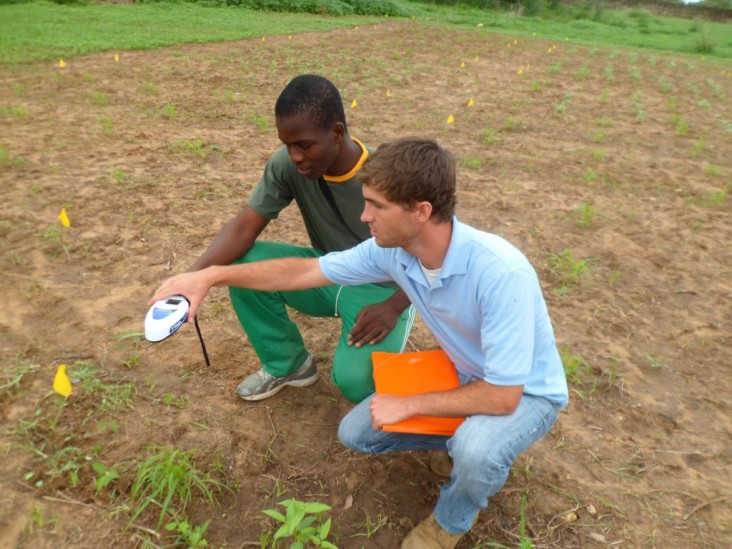
Thiès, Senegal—In the midst of a test plot marked with yellow flags, two young scientists work together amid multiple rows of small millet plants, manipulating an electronic device used to measure the strength of the plants. Neither seems to mind the light rain as they note the data registering from the machine.
One of the scientists is Muhammad Sarr, a 27-year-old forestry engineer and recent graduate of Senegal’s Higher Institute for Agricultural and Rural Education, known as ENSA. The other is Patrick Trail, 23, an American graduate student from the Department of Crop and Soil Environmental Science at Virginia Tech University, which implements a key USAID program under Feed the Future, the U.S. Government's global hunger and food security initiative.
USAID's Education and Research in Agriculture project (ERA) is designed to increase yields of millet despite unpredictable rainfall by planting the crop with legumes to conserve water and add nutrients to the soil. Strengthening the millet value chain, from planting and cultivating through processing and sale, is a main focus of Feed the Future in Senegal. Other key value chains include rice, corn and fisheries.
“With these experiments on this technique of conservation agriculture, we hope to improve millet production among small farmers and beyond to combat food insecurity,” Trail explained in summer 2013 as he checked his equipment readings. “Since millet is a staple crop in Senegal, I am collaborating with local institutions as part of my studies.”
Virginia Tech, among a small group of American universities devoted to the instruction of technical arts and applied sciences, is the main implementer of the five-year ERA project, which collaborates with a dozen additional institutes of higher education and research in the United States and Senegal.
Sarr explained the research involves a plot of 800 square meters, divided into eight sections, where millet is combined with three different varieties of legumes selected during a pre-trial. The researchers are comparing the potential benefits of the mixture—providing ground cover, blocking weeds and impact on soil—through analysis of its moisture level and nutritional quality.
“We’re trying to find the best mix,” Sarr said. “We also expect to increase yields through intercropping, because legumes have the ability to absorb atmospheric nitrogen which is essential for plant growth. Legumes grow leaves that cover the ground, which reduces evaporation. The bonus is that people can eat them as well.”
Trail adds that the scope of the research goes beyond collection of scientific results, and importantly aims to improve skills of research students in agronomy. “This can be as important as the results that we get,” he said. “It’s crucial to involve institutions in the global scientific method, which will ultimately serve all students in the future.”
One of the major goals of the exchange program is to prepare institutions to enable students to drive their own agricultural research. ERA is involving additional students at Senegal’s two main agricultural research institutes to take daily measurements and maintain the plots, for which they can get credit towards graduation.
“We’re working with Senegalese students who previously didn’t have the capacity for research at this level," said Patrick Guilbaud, director of ERA. “The exchange helps them master the techniques so they can in turn work with local farmers and apply the same approaches.” Likewise, Guilbaud said, American research students would never have such an opportunity to make a demonstrable impact on food security in the developing world.
“The more students that have access to projects like this will ensure that work continues long after I return to Virginia Tech,” says Trail. “It’s a win-win partnership for all.”
The ERA project aims to improve agricultural education at the college level, increase exports, and fight against hunger and food insecurity in Senegal. Since the project began in 2010, Virginia Tech has partnered with four American universities—Connecticut, Michigan State, Purdue and Tuskegee—as well as with Senegalese agriculture experts to strengthen the country's agricultural education sector.







Comment
Make a general inquiry or suggest an improvement.